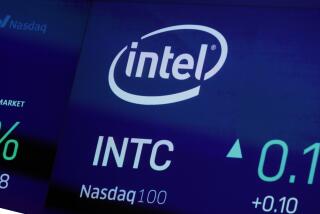Fresh Challenges Beset New Intel CEO
- Share via
SAN FRANCISCO — The honeymoon ended before it ever really started for Craig Barrett, the new chief executive of Intel Corp. who spent years waiting to take the helm of a juggernaut but inherited a company beset by serious problems.
On Monday, less than three weeks into Barrett’s tenure, the troubles intensified when Intel was hit with an antitrust suit by the Federal Trade Commission. But that is just one entry in a list of woes ranging from falling prices of personal computers to the rising popularity of devices that don’t use the company’s chips.
Many believe that Barrett, a politically savvy executive known for his cool head and pragmatic style, is ideally suited to handle the issues facing the world’s dominant maker of microprocessors, particularly the FTC suit.
But analysts also say that Barrett, 58, probably never expected the path to become perilous so quickly after he took the reins from his legendary predecessor, Andrew Grove.
“The transition between Grove and Barrett was smooth, but life at Intel is not,” said Michael Slater, principal analyst at MicroDesign Resources, an industry think tank in Sebastapol. “Intel is definitely not in position to just cruise.”
Not so long ago, the Santa Clara company seemed to be on cruise control as profits soared from $1.07 billion in 1992 to $6.9 billion last year.
It would have been daunting enough for Barrett simply to try to maintain that rate of growth. But Barrett, who has been with the company for 23 years, stepped into the post just as expectations were peaking and new pitfalls emerging.
Asian currency problems have dampened demand. PC prices are in a yearlong plunge, delivering a damaging blow to Intel, which built its empire on premium-priced chips.
Meanwhile, the market’s embrace of a new generation of devices, including palmtop computers and television set-top boxes, has caught Intel off-guard. Topping it off is the FTC suit, which accuses the company of abusing its monopoly position to cut out competitors.
Barrett spent years in the shadow of Grove, who led Intel during its greatest period of growth and was so widely revered that he was named Time magazine’s man of the year shortly before he stepped down.
But analysts say that Barrett may be better equipped than Grove to deal with some of the challenges that now confront Intel, including the FTC suit. For starters, colleagues say, Barrett is more politically attuned and even-tempered than Grove.
“Barrett is much more likely to settle with the FTC than Grove would have been,” Slater said. “Barrett seems much more willing to compromise and not waste Intel’s energy fighting something that isn’t worth fighting.”
In fact, Barrett often played a key role in resolving previous legal scrapes at Intel. It was Barrett, not Grove, who brokered the deal to end the company’s lengthy legal battle with Advanced Micro Devices in 1995.
Barrett has also established himself as an industry statesman in Washington.
“Barrett has been one of the major cleanup hitters for the chip industry when it comes to meeting people in Washington,” said Jeff Weir, a spokesman for the Semiconductor Industry Assn. in San Jose.
Barrett even has familial connections. His wife is a former gubernatorial candidate in Arizona and previously held a top position with the Federal Aviation Administration.
Barrett must still find a way to align Intel with industry trends that threaten the company. But with 85% of the PC microprocessor market and $10 billion in reserves, Barrett isn’t without resources.
As one analyst said: “One can’t grumble too much about inheriting the world’s biggest semiconductor company.”
(BEGIN TEXT OF INFOBOX / INFOGRAPHIC)
Processing Power
Intel Corp. dominates the worldwide market for microprocessors and chip sets:
Central Processing Units
Market share in 1997:
Intel: 81.9%
AMD: 7.0%
Power PC*: 3.6%
Cyrix: 3.4%
IBM: 2.6%
Other: 1.5%
Chip Sets
Market share in 1997:
Intel: 71%
Via Technologies: 11%
Acer Laboratories: 8%
FIC: 8%
Other: 2%
*includes IBM and Motorola
Source: Mercury Research






